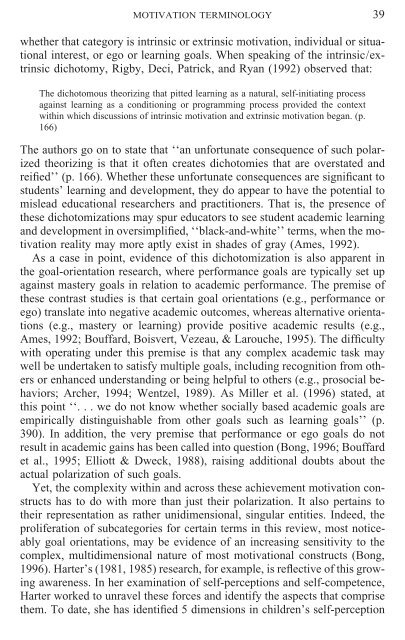A Motivated Exploration of Motivation Terminology - Anitacrawley.net
A Motivated Exploration of Motivation Terminology - Anitacrawley.net
A Motivated Exploration of Motivation Terminology - Anitacrawley.net
You also want an ePaper? Increase the reach of your titles
YUMPU automatically turns print PDFs into web optimized ePapers that Google loves.
MOTIVATION TERMINOLOGY 39whether that category is intrinsic or extrinsic motivation, individual or situationalinterest, or ego or learning goals. When speaking <strong>of</strong> the intrinsic/extrinsicdichotomy, Rigby, Deci, Patrick, and Ryan (1992) observed that:The dichotomous theorizing that pitted learning as a natural, self-initiating processagainst learning as a conditioning or programming process provided the contextwithin which discussions <strong>of</strong> intrinsic motivation and extrinsic motivation began. (p.166)The authors go on to state that ‘‘an unfortunate consequence <strong>of</strong> such polarizedtheorizing is that it <strong>of</strong>ten creates dichotomies that are overstated andreified’’ (p. 166). Whether these unfortunate consequences are significant tostudents’ learning and development, they do appear to have the potential tomislead educational researchers and practitioners. That is, the presence <strong>of</strong>these dichotomizations may spur educators to see student academic learningand development in oversimplified, ‘‘black-and-white’’ terms, when the motivationreality may more aptly exist in shades <strong>of</strong> gray (Ames, 1992).As a case in point, evidence <strong>of</strong> this dichotomization is also apparent inthe goal-orientation research, where performance goals are typically set upagainst mastery goals in relation to academic performance. The premise <strong>of</strong>these contrast studies is that certain goal orientations (e.g., performance orego) translate into negative academic outcomes, whereas alternative orientations(e.g., mastery or learning) provide positive academic results (e.g.,Ames, 1992; Bouffard, Boisvert, Vezeau, & Larouche, 1995). The difficultywith operating under this premise is that any complex academic task maywell be undertaken to satisfy multiple goals, including recognition from othersor enhanced understanding or being helpful to others (e.g., prosocial behaviors;Archer, 1994; Wentzel, 1989). As Miller et al. (1996) stated, atthis point ‘‘. . . we do not know whether socially based academic goals areempirically distinguishable from other goals such as learning goals’’ (p.390). In addition, the very premise that performance or ego goals do notresult in academic gains has been called into question (Bong, 1996; Bouffardet al., 1995; Elliott & Dweck, 1988), raising additional doubts about theactual polarization <strong>of</strong> such goals.Yet, the complexity within and across these achievement motivation constructshas to do with more than just their polarization. It also pertains totheir representation as rather unidimensional, singular entities. Indeed, theproliferation <strong>of</strong> subcategories for certain terms in this review, most noticeablygoal orientations, may be evidence <strong>of</strong> an increasing sensitivity to thecomplex, multidimensional nature <strong>of</strong> most motivational constructs (Bong,1996). Harter’s (1981, 1985) research, for example, is reflective <strong>of</strong> this growingawareness. In her examination <strong>of</strong> self-perceptions and self-competence,Harter worked to unravel these forces and identify the aspects that comprisethem. To date, she has identified 5 dimensions in children’s self-perception
















